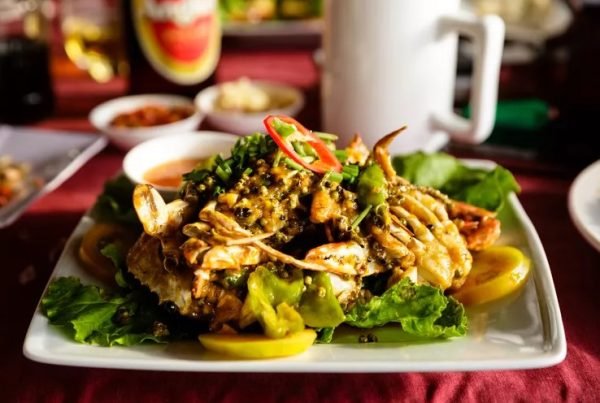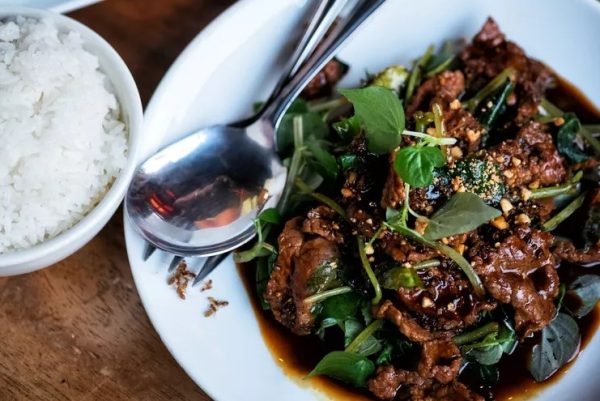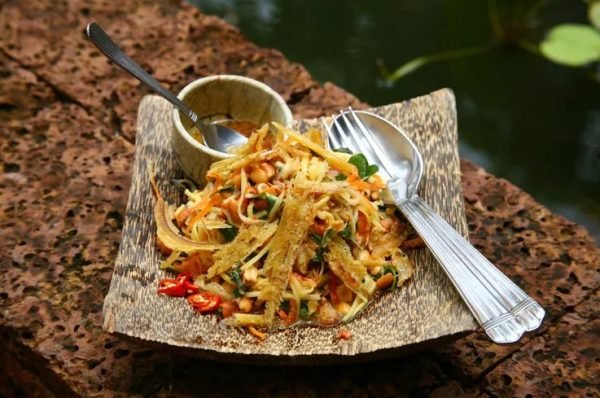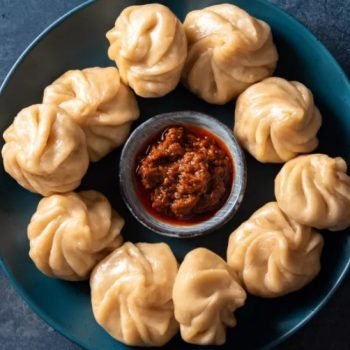Nom Banh Chok
They are often called plain “Khmer noodles” in English, but nom banh chok has a much wider regional variation than the name implies. Made from rice noodles combined with a fish-based curry gravy and assorted local vegetables, nom banh chok is a favorite breakfast for Cambodians up and down the country. It’s often sold on the street by women balancing the ingredients on bamboo poles.

Different cities throughout Cambodia have their own take on nom banh chok. Kampot’s version uses sweet dried shrimp and fish sauce as a flavor base while in Siem Reap it is served with a sweet sauce made from palm sugar, and cooks pile on the garlic and coconut milk.
Kari Sach Moan
Cambodia’s local chilies are much less fiery than their counterparts in Thailand—thus kari sach moan (the local chicken curry) has a balance to its richness that will keep you coming back for more despite the large pepper pieces sprinkled throughout. A kroeung spice paste is cooked in coconut cream with chicken and sweet potatoes; the resulting dish is eaten with rice, noodles, or even sliced baguettes.

Traditionally, kari sach moan wasn’t eaten as an everyday dish but reserved for special occasions like weddings.
Cha Kdam
The seaside town of Kep makes the most of the abundance of crabs in its waters. In the dish called cha kdam, locals stir-fry slices of crab with green Kampot peppers. The melted fat from the crab blends with the sharp spiciness of the peppercorns, transforming the seafood with the distinctive aroma and flavor of the indigenous spices.

Forget about using utensils when chowing down on cha kdam—this dish is best eaten with one’s hands (the crab meat is impossible to extract from the shells otherwise).
Ongkrong Saek Koo
Sure, tarantulas take most of the spotlight for insect-based foods in Cambodia—but indigenous red tree ants offer a more wholesome meal, a “spice” of sorts for ongkrong saek koo. The ants add a tangy flavor dimension to this dish of beef cooked in holy basil.

Beef is not a traditional Cambodian dish—for millennia, Khmer subsisted on fish as their main protein, but adapted after Europeans introduced beef to local tables. Cambodian cooks stir-fry thin slices of beef with ginger, garlic, lemongrass, shallots, and chilies along with whole ants and larvae.
Chruok Svay
The Khmer love unripe fruit in their salads, relishing their tangy sharpness that perfectly complements the umami of their roast meats and curries. Green mango salad, or chruok svay, combines sour green mango slices with fish sauce, dried shrimp, peanuts, tomato, shallots, onions, Asian basil, and mint.

Chruok svay is in abundance during mango season from March to July; if not eaten with a full meal, you can also enjoy it as a light snack or appetizer.
Beef Lok Lak
The name beef lok lak literally translates to “shaking beef,” so named because of how cooks shake the skillet as they stir-fry beef cubes in pepper sauce or oyster sauce. The “shaken” beef is then served on top of tomatoes, lettuce, and raw onions.

The French introduced beef as a foodstuff to Cambodia during their 19th- and 20th-century colonial rule. The dish was then localized into the form we know today, served with a dipping sauce of lime juice, fish sauce, and pepper. It is eaten with rice, but very occasionally it’s served with French fries on the side.

